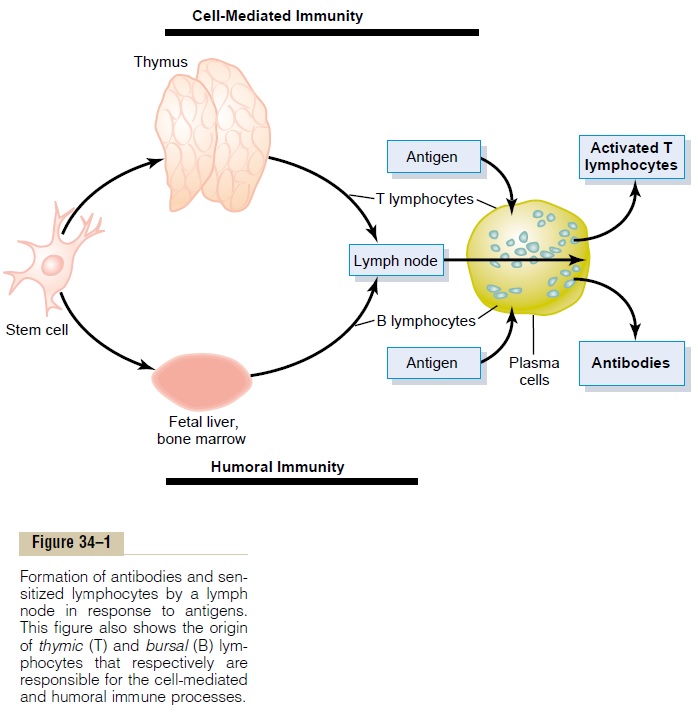Chapter: Medical Physiology: Resistance of the Body to Infection: II. Immunity and Allergy
Lymphocytes Are Responsible for Acquired Immunity
Lymphocytes Are Responsible for Acquired Immunity
Acquired immunity is the product of the body’s lymphocytes. In people who have a genetic lack of lym-phocytes or whose lymphocytes have been destroyed by radiation or chemicals, no acquired immunity can develop. And within days after birth, such a person dies of fulminating bacterial infection unless treated by heroic measures. Therefore, it is clear that the lym-phocytes are essential to survival of the human being.
The lymphocytes are located most extensively in the lymph nodes, but they are also found in special lym-phoid tissues such as thespleen, submucosal areas of the gastrointestinal tract, thymus, and bone marrow.The lymphoid tissue is distributed advantageously in the body to intercept invading organisms or toxins before they can spread too widely.
In most instances, the invading agent first enters the tissue fluids and then is carried by way of lymph vessels to the lymph node or other lymphoid tissue. For instance, the lymphoid tissue of the gastrointestinal walls is exposed immediately to antigens invading from the gut. The lymphoid tissue of the throat and pharynx (the tonsils and adenoids) is well located to intercept antigens that enter by way of the upper res-piratory tract. The lymphoid tissue in the lymph nodes is exposed to antigens that invade the peripheral tissues of the body. And, finally, the lymphoid tissue of the spleen, thymus, and bone marrow plays the specific role of intercepting antigenic agents that have suc-ceeded in reaching the circulating blood.
Two Types of Lymphocytes Promote “Cell-Mediated” Immunity or “Humoral” Immunity—the T and the B Lymphocytes.Although most lymphocytes in normal lymphoid tissue look alike when studied under the microscope, these cells are distinctly divided into two major populations. One of the populations, the T lympho-cytes, is responsible for forming the activated lympho-cytes that provide “cell-mediated” immunity, and the other population, the B lymphocytes, is responsible for forming antibodies that provide “humoral” immunity.
Both types of lymphocytes are derived originally in the embryo from pluripotent hematopoietic stem cells that form lymphocytes as one of their most important offspring as they differentiate. Almost all of the lym-phocytes that are formed eventually end up in the lymphoid tissue, but before doing so, they are further differentiated or “preprocessed” in the following ways.
The lymphocytes that are destined to eventually form activated T lymphocytes first migrate to and are preprocessed in the thymusgland, and thus they are called “T” lymphocytes to designate the role of the thymus. They are responsible for cell-mediated immunity.
The other population of lymphocytes—the B lym-phocytes that are destined to form antibodies—are preprocessed in the liver during midfetal life and in the bone marrow in late fetal life and after birth. This pop-ulation of cells was first discovered in birds, which have a special preprocessing organ called the bursa of Fabri-cius. For this reason, these lymphocytes are called “B” lymphocytes to designate the role of the bursa, andthey are responsible for humoral immunity. Figure 34–1 shows the two lymphocyte systems for the for-mation, respectively, of (1) the activated T lympho-cytes and (2) the antibodies.

Related Topics